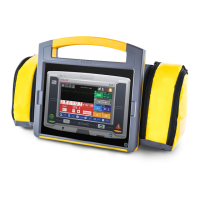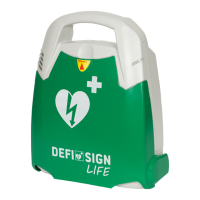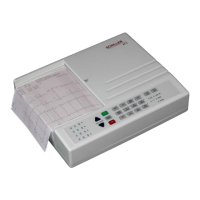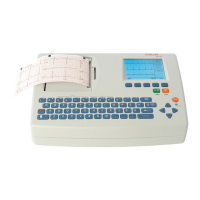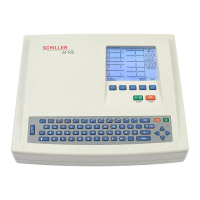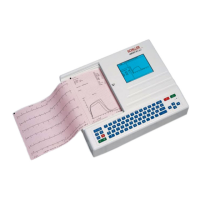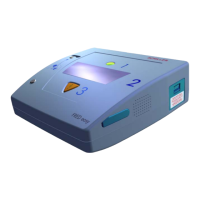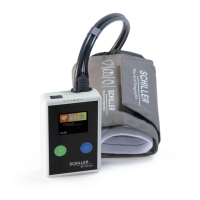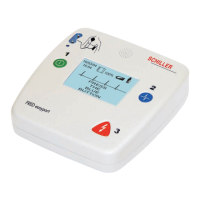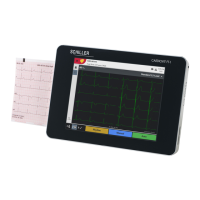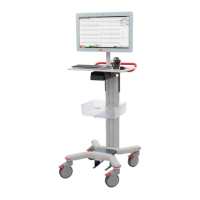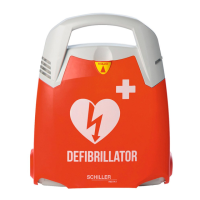Do you have a question about the Schiller DEFIGARD Touch 7 and is the answer not in the manual?
Defines user roles and required qualifications for operating the device.
Outlines the primary functions and applications of the DEFIGARD/PHYSIOGARD Touch 7 devices.
Lists conditions and situations where the device should not be used.
Details the user's obligations for safe and proper operation of the device.
Provides critical guidelines for safe operation, handling, and environment.
General guidance on device maintenance and safety precautions.
Overview of the device's construction, power supply, and core functionalities.
Detailed description of the device's physical and interactive components.
Describes the main display screen layout and elements.
Guide on powering the device using external DC or internal battery.
Steps for connecting and operating the device with an external DC power source.
Information on battery status, charging, and low battery indications.
Procedures for safely powering down and disconnecting the device.
Overview of the display layout, soft keys, and measurement fields.
Comprehensive guide to the device's alarm system, priorities, and indicators.
Classification of alarms based on type and priority level.
Explains physiological alarm triggers, sounds, and display indicators.
Details technical errors, their codes, and display indicators.
How to configure custom alarm limits for patient monitoring.
Default and adjustable ranges for vital parameter alarms.
Procedures for ECG monitoring, electrode placement, and HR detection.
Steps to initiate and configure ECG monitoring.
Special considerations for monitoring patients with pacemakers.
Guide to using pulse oximetry and CO-oximetry features.
Factors affecting SpO2, SpCO, and SpMet measurement accuracy.
Instructions for performing non-invasive blood pressure measurements.
Guide to invasive blood pressure monitoring.
Instructions for measuring patient temperature.
Guide to using the IRMA mainstream CO2 sensor.
Guide to using the ISA sidestream CO2 sensor.
Essential safety rules and guidelines for performing defibrillation.
Specific safety precautions for using the AED mode.
Guidelines for defibrillation on pediatric and neonatal patients.
Overview of the DEFIGARD® Touch 7's defibrillation capabilities.
Steps to switch the device to manual defibrillation mode.
Steps to activate the AED mode for emergency use.
Instructions for applying defibrillation pads and electrodes.
Guide to synchronized defibrillation mode and its operation.
Instructions for using the semi-automated defibrillation mode.
Step-by-step guide for AED operation.
Features and guidance for cardiopulmonary resuscitation.
Overview of the external transcutaneous pacemaker module.
Critical safety warnings related to pacemaker use.
General guidelines for applying pacemakers and electrodes.
Steps to turn on and initiate the pacemaker function.
Procedures for reviewing, transmitting, and testing intervention data.
Accessing and configuring device settings and parameters.
Schedules and responsibilities for routine device maintenance.
Procedures for performing functional tests on the device.
Instructions for updating the device software via USB or server.
Guidelines for battery maintenance and replacement.
Troubleshooting guide for common device errors and issues.
Available methods for charging the device's batteries.
Procedure for calibrating the device's batteries.
General specifications and operating conditions for the device.
Technical specifications of the defibrillation waveform.
Performance data for the Shock Advisory System.
Technical specifications for the pacemaker function.
Detailed technical data for patient monitoring parameters.
Technical specifications related to ECG monitoring.
Technical specifications for NIBP measurements.
Technical specifications for IBP measurements.
Technical specifications for temperature monitoring.
Technical specifications for SpO2 monitoring.
Technical specifications for etCO2 monitoring.
Settings and parameters for configuring the device.
| Brand | Schiller |
|---|---|
| Model | DEFIGARD Touch 7 |
| Category | Medical Equipment |
| Language | English |
